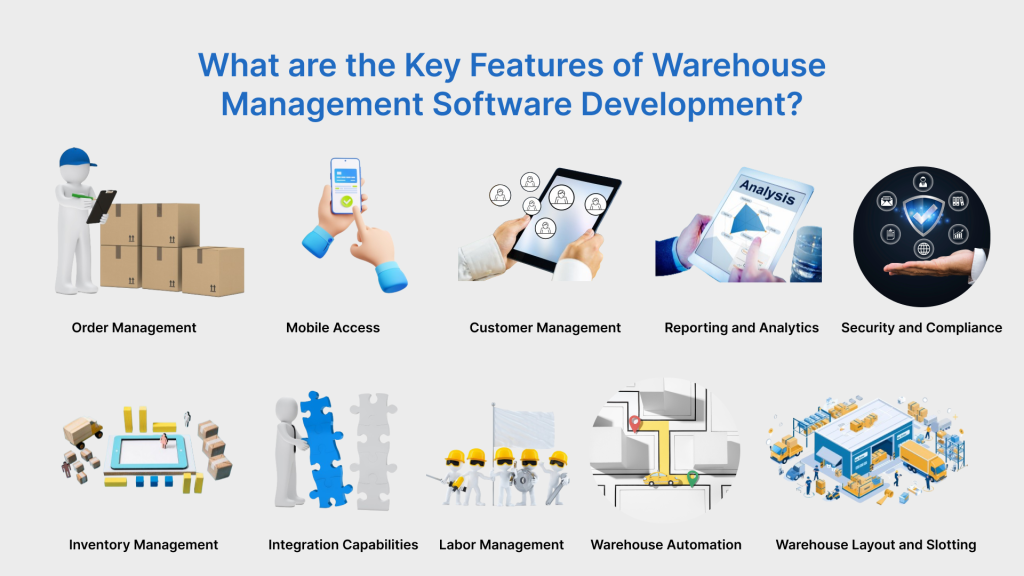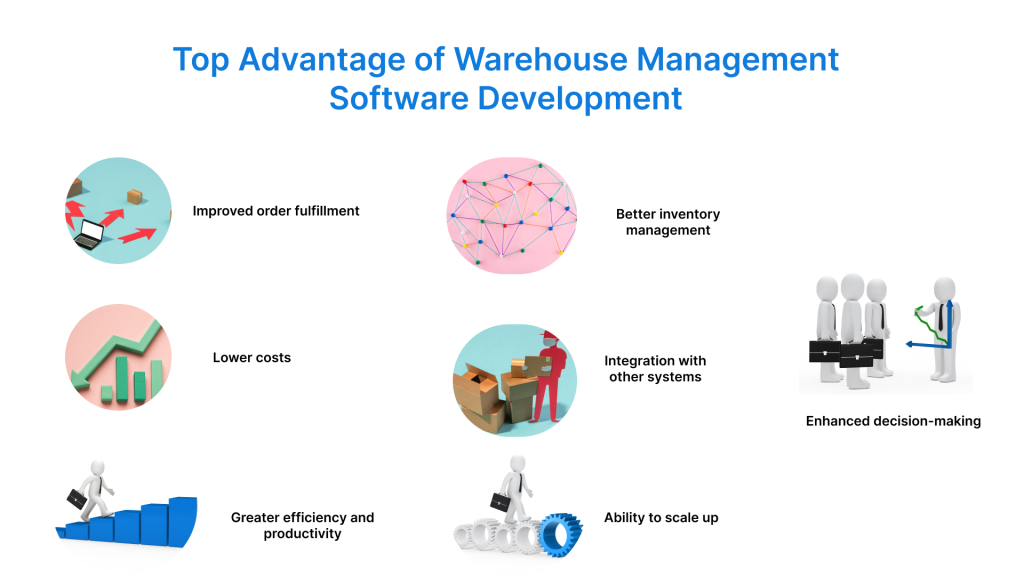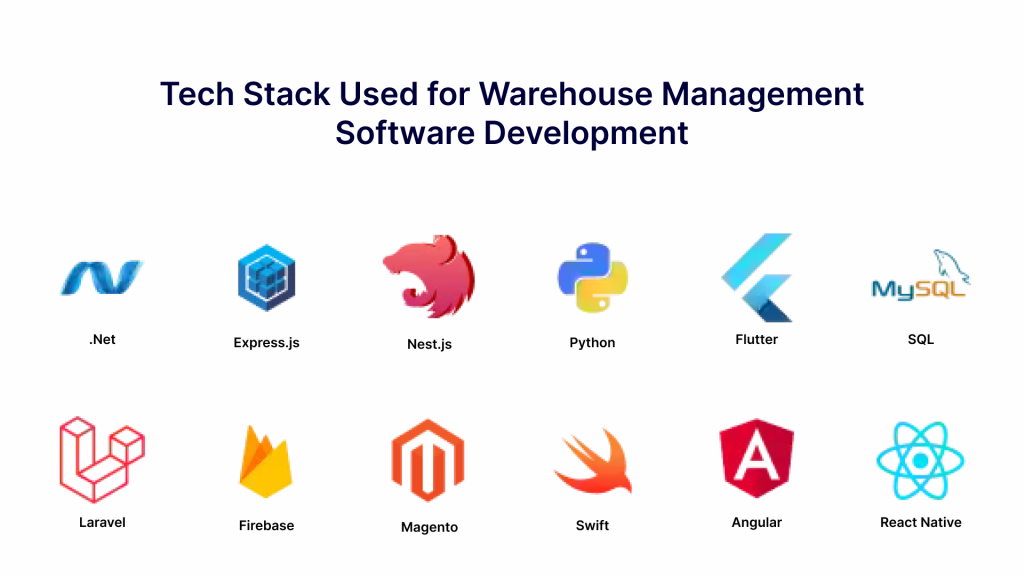In today’s technological world, managing warehouse activities becomes crucial for businesses to stand out from their competitors. As the supply chain is complex and customer expectations increase, manual methods are not enough to handle modern warehousing needs. This is where the requirement for Warehouse Management Software Development feels. This tool offers a tech-based solution that streamlines tasks, optimizes resource use, and improves overall efficiency.
Warehouse operations rely heavily on warehouse management systems, which are crucial for managing inventory, processing orders, and keeping the warehouse efficient. However, selecting the right features for your business can be challenging because there are so many options to choose from in WMS software.
The growing need for warehouse management software has led industries such as healthcare, retail, and manufacturing to use these solutions. This helps them work more efficiently and respond to customer needs quickly.
In this blog, we’ll explore the overall concepts including warehouse management software features, advantages, cost-consideration, trending tech stack, and which factors the overall cost of WMS development.
What is Warehouse Management Software?
A warehouse management system is a tool that is popularly used by multinational and small-scale organizations to handle and control warehouse activities and operations. The tool provides a central system for tracking inventory, managing staff, handling errors, and optimizing storage. A good system like WMS can automate tasks such as receiving goods, storing items, picking orders, and shipping products. By making this procedure more efficient, warehouse management software helps businesses to boost sales, improve accuracy, reduce costs, and enhance customer satisfaction.
Moreover, WMS is crucial as it tracks all materials in the warehouse and helps the company pick and pack products. It also monitors merchandise as it arrives, gets stored on shelves, and is shipped out for orders.
Market Stats of Warehouse Management Software Development



- The global warehouse management system market is expected to grow from $4.0 billion in 2024 to $8.6 billion by 2029, with an annual growth rate of 16.3%. The government’s share of this market has been 0% since 2023 and is expected to remain at 0% until 2030.
- Using the automated Warehouse Management System also enhanced productivity by 25-30% and cut down on errors.
- Automation and real tracking have boosted picking and shipping efficiency by 70%.
- The risk of not using WMS is greater than the cost of implementing it. Companies often get a return on investment within one year. ‘
- More than 85% of retail warehouses use the warehouse management system to streamline tasks and make operations smoother.
What are the Key Features of Warehouse Management Software Development?



To effectively manage and improve warehouse operations, it’s important to include a range of features and modules. Here are the key features and modules to consider. Warehouse Management Software Development offers incredible features that maximize the visibility of supply chain and efficiency.
Order Management
The feature streamlines the creation, modification, and fulfillment of orders. It also enhances the process of picking and packing orders to reduce mistakes and delays. Integrate with shipping providers to print labels, track shipments, and manage deliveries efficiently.
Mobile Access
Creating a custom mobile app for warehouse staff to access the system from anywhere. This provides flexibility and responsiveness. Additionally, mobile scanning is another key feature to consider that allows staff to use mobile devices to scan barcodes. WMS makes the overall inventory management procedure smoother and easier.
Customer Management
Adding the feature “customer profile” helps to keep a detailed record of customers including their order history and preferences. Moreover, communication tools are also useful to update customers about their order status, shipping details, and other essential details.
Reporting and Analytics
This feature allows users to track key performance indicators in real-time by using customizable dashboard tools. Moreover, Data analytics helps in examining trends and patterns in the data. This gives insights into demand and valuable information for business decisions. Compliance reporting involves generating reports to ensure adherence to customer and trade regulations and guidelines.
Security and Compliance
It’s important to have strong security systems and password controls to ensure that only authorized people can access the system. However, encryption to safeguard sensitive data while it’s being sent and stored.
Inventory Management
Real-time tracking helps you monitor current inventory levels to avoid running out of popular items or having too many of others. Using barcode and RFID technology makes it easier to quickly locate items. Setting up automatic reordering helps maintain the right stock levels and ensures you have enough products to meet demand.
Integration Capabilities
Connecting the WMS with the Enterprise Resource Planning (ERP) ensures smooth data exchange. Also, businesses can link the tool with e-commerce vendors to manage orders and inventory in real time. The other key feature that should be considered the API access. This means you should allow access to your business’s APIs to integrate with other business apps or third-party software.
Labor Management
Employee scheduling involves creating work schedules to meet the staffing needs for different shifts. Performance tracking is about assessing employee’s work in the company, identifying their strengths and weaknesses and motivating workers who perform well.
Warehouse Automation
Automated Guided Vehicles (AGVs) help reduce the need for manual handling of materials by using automated equipment for moving items. Robotic Process Automation (RPA) can be used to take care of routine tasks like data entry and inventory checks.
Warehouse Layout and Slotting
Arrange the store’s layout to make the best use of the space available. Analyze where items should be placed based on how often they’re needed and when they’re most likely to be used.
Types of Digital Hardware Used with Warehouse Management Software?



Using warehouse management software with digital hardware is key to improving operations, accuracy, efficiency, etc. With Warehouse Management Software Development, every business gets better control over inventory and conducts real-time tracking smoothly. In this paragraph we will go through the different types of digital hardware used with warehouse management software.
Barcode Scanners
Barcode scanners are crucial for managing stock and other parts of the business. They speed up item identification, reducing errors and making the process easier compared to manually handling barcodes.
RFID Readers
Most stocks and assets use RFID tags for real-time tracking. RFID readers can scan these tags without needing to touch them. This makes easy to track many items at one time and reduce the overall burden.
Mobile Devices
RF technology in handheld devices and tablets allows warehouse staff to access the WMS on their mobile devices easily. This boosts mobility, reduces the need for multiple stationary desks, improves productivity, and so on.
Automated Guided Vehicles (AGVs)
AGVs help automate moving and handling of materials in a warehouse. They work well with warehouse management software to run the operation smoothly and boost efficiency.
Wearable Technology
Wearable devices like smart glasses and wrist scanners can boost productivity and accuracy in warehouses. They offer real-time information and allow for hands-free work.
IoT Sensors
IoT sensors can track things like temperature and humidity in a warehouse. This keeps storage conditions just right and helps protect delicate items from damage or any cracks. The IoT sensors helps to reduce the cost of damage, loss, or defect in a product.



Top Advantage of Warehouse Management Software Development



As businesses are becomes more aware of the importance of warehouse management software development and its amazing benefits. Warehouse management software is an essential tool for small or large-scale businesses. It improves efficiency in order fulfillment and also helps to boost overall company performance. A WMS is also useful for tracking what items are selling which works well with managing stock. Additionally, it monitors raw materials as they arrive, making it easier to store and organize them for production. Here are some top advantages of warehouse management software development:-
Improved order fulfillment
WMS handles activities such as order picking, tracking status, packing, and dispatching to minimize errors that may lead to delays in delivery.
Lower costs
Warehouse Management Software also offers the incredible benefits of reducing operational costs by enhancing effectiveness and efficiency. This overall process enables to minimization of costs and mistakes.
Greater efficiency and productivity
Automation also removes time-consuming and complex manual warehouse tasks. This results in faster processing, better use of space, and more efficient storage solutions in the warehouse.
Better inventory management
WMS offers up-to-date information on stock levels, activities within the warehouse and locations. This helps with stock management by reducing over stock and shortage and keeps the stock level balanced.
Integration with other systems
Warehouse management software development services can connect with other business systems like ERP (Enterprise Resource Planning), TMS (Transportation Management System), and CRM (Customer Relationship Management). This integration allows for smooth data sharing and enhances overall business operations.
Ability to scale up
Using offshore software development services can help fulfill an organization’s needs and support its growth. It can assist with expanding to new warehouses or managing a larger inventory and contribute in the company’s growth.
Enhanced decision-making
WMS also offers benefits through advanced analytics and reporting tools that help track and evaluate warehouse performance. These tools are useful for making decisions, identifying weak spots, and applying strategies to improve overall efficiency.
Tech Stack Used for Warehouse Management Software Development



Worrying about choosing the right technology? Just contact our skilled team at eBizneeds for customized solutions! Developing warehouse management software requires choosing the right technology to support functions like inventory tracking, order management, and system integration. Here’s a tech stack that works well for WMS development.
Frontend Development
Languages: – Use HTML, CSS, and JavaScript to create the user interface.
Frameworks/Libraries: – Build responsive and interactive web applications with React.js, Angular, or Vue.js.
Backend Development
Programming Languages:– Java, C#, or Python for creating the backend logic.
Frameworks:– Spring Boot (Java), ASP.NET Core (C#), or Django (Python) to speed up development and make it easier to maintain.
Database Management
Relational Databases: – Use PostgreSQL or MySQL for organizing structured data.
NoSQL Databases:- Use MongoDB for managing unstructured data.
API Development
RESTful APIs: – Used for connecting the frontend with the backend.
GraphQL: – Provides a more efficient and flexible way to query data.
Cloud Services
Platforms: – Use AWS, Microsoft Azure, or Google Cloud Platform for hosting and scaling your services.
Services: – Store and manage your data with AWS S3, Azure Blob Storage, or Google Cloud Storage.



What is the Cost of Developing Warehouse Management Software?
The cost of developing warehouse management software can vary based on factors like the features you need, the size of the development team, the tools and technologies used, and the location of the Custom Software development company or developers. Generally, the cost can range from $30,000 to $250,000. Several factors influence the overall development cost. These include the software consulting company’s experience and location, the technology used for WMS development, the features added, the length of development cycles, the level of integration, maintenance costs, and the user functionalities included.
| Type of Warehouse Management System | Estimated Average Cost of Development | Time Frame |
| Basic | $30,000 to $60,000 | 3 to 6 months |
| Medium Complex | $75,000 to $120,000 | 6 to 8 months |
| Highly Complex | $135,000 to $250,000 | 9+ months |
Team Structure for Building Warehouse Management Software
Setting up warehouse management software (WMS) involves creating the right team framework to improve project delivery and run the project efficiently.
Project Manager
The main responsibility of Project managers is to handle the development of the whole product and ensure smooth communication between teams to meet deadlines. The primary goal is to check the task should be completed within the timeframe. They handle planning, budget control, financing and keep stakeholders informed.
Business Analysts
They talk to the end-users to understand and document their needs in order to achieve the goals of the warehouse processes.
Software Developers
If you planning for a Warehouse Management System (WMSt) then it’s crucial to hire skilled software developers who can deliver a high-quality product. Make sure they understand and include all the details and features you need while also keeping up with market trends. The team should include both front-end and back-end developers.
Quality Assurance (QA) Testers
Quality Assurance (QA) testers play a vital role in developing a WMS system. They ensure your final product meets quality standards by finding and fixing issues in the program. We provide various tests, including functional, performance, and security testing, to make sure everything works well.
UX/UI Designers
It’s best to design natural interfaces and user experiences when creating software to make it easier and more effective to use.
System Architects
System Architects decide how the software will be set up, how it will work with other software in the company and how it can be upgraded or expanded later.
Support and Maintenance Team
You should keep helping after the launch and handle any changes or issues that come up. This includes finding any issues, upgrading features on the basis of feedback and make sure everything runs smoothly. The ongoing support and maintenance are crucial to keep the system working well and meeting user’s needs effectively.
Why Choose eBizneeds for Warehouse Management Software Development?
A good warehouse management system can boost your operations by increasing efficiency, speed, and order accuracy. This not only improves your company’s profits but also enhances customer satisfaction while lowering operating costs. We recently implemented a supply chain management system for a global manufacturing company. Thanks to AI and analytics, they saw a 60% improvement in supply chain visibility and a 40% reduction in transportation and logistics costs. If you’re interested in a warehouse management system for your business, eBizneeds offers custom software development tailored to your brand and values. Contact our team, we’ll be happy to assist you!
Conclusion
Warehouse Management Software development is crucial for organizations aiming to improve facility operations and stay competitive. This type of system offers many benefits, including easier inventory control, improved order processing, increased efficiency, cost savings, better decision-making, scalability, and compatibility with other systems. If you want to upgrade your inventory management and streamline your operations, you’re in the right place. We provide top-notch Warehouse Management Software solutions.
FAQs
Warehouse Management Software is a digital tool that helps you handle and improve warehouse tasks such as tracking inventory, fulfilling orders, and managing warehouse space.
There is no key formula to measure the exact cost of warehouse management software development. Usually, building a WMS system may range between $30,000 to $250,000. The cost will be higher for an advanced system.
Warehouse management software boosts efficiency by improving inventory control, and order accuracy, and cutting operational costs. It simplifies processes, provides real-time tracking, and increases productivity with automation.
The timeframe of creating warehouse management software may vary based on different factors such as features, complexity, development team size, and customization. A basic system might be ready in 3-6 months but a more complex software can take over one year. If you want to get an accurate timeframe then it’s essential to contact a reliable warehouse management software company.
Warehouse management software should have features like:-
Inventory tracking
Order management
Real-time data analytics
Barcode scanning
System integration
Customizable reports
Automated alerts
All these features should be included in order to improve efficiency and accuracy.
A typical team has a:
1. Project Manager
2. Business Analyst
3. UI/UX designer
4. Front-end Developers
5. Back-end Developers
6. Mobile Developers
7. DevOps Engineer
8. QA Testers
9. Security Specialist
10. Technical Support.



Naveen Khanna is the CEO of eBizneeds, a company renowned for its bespoke web and mobile app development. By delivering high-end modern solutions all over the globe, Naveen takes pleasure in sharing his rich experiences and views on emerging technological trends. He has worked in many domains, from education, entertainment, banking, manufacturing, healthcare, and real estate, sharing rich experience in delivering innovative solutions.


